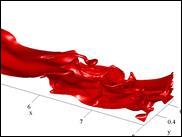Current Research Activities

I am an applied mathematician by training, interested in the application of any mathematical tool to any problem of practical interest, especially the difficult ones. My current research activity lies in viscous interfacial flows, and I model interfacial evolution using tools from stability analysis and direct numerical simulation.
Viscous interfacial flows - Modelling
The focus of my modelling work is understanding the linear stability of an idealized system -- a two-phase pressure or gravity-driven channel flow. The system is stably stratified and a more viscous fluid sits in the bottom layer. A Poiseuille-like profile is the base state. It is of interest to know when this base state becomes unstable. The answer is provided by Orr-Sommerfeld analysis.
The main aim of my work is the extension of this rather classical problem to classify the instability in full generality. This is accomplished by studies of transient growth and absolute and convective instability. I have developed a range of my own non-standard methodologies to answer these questions thoroughly, with minimal computational effort.
In many practical applications, either or both phases are turbulent, meaning that the Poiseuille-like profile is no longer relevant. In this case, linear stability analysis can still be conductued, using the classical quasi-laminar hyphothesis of Miles, with detailed turbulent modelling for the base state in question.
Viscous interfacial flows - Simulation
It is not enough to understand the linear stability properties of two-phase flows, since in many situations, the base state is strongly unstable, and large-amplitude waves form rapidly, leading to subsequent wave overturning, ligament formation, and droplet entrainment.
For that reason, my collaborators and I have developed a parallel two-phase levelset solver (TPLS) to simulate extremely non-linear interfacial evolution in three-dimensional channel flows. Future work will involve the extension of this code to non-channel geometries, and to the fine-tuning of the code for use at higher Reynolds numbers.